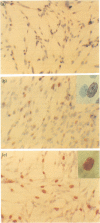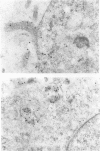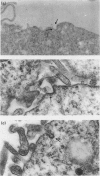Abstract
We have investigated the growth-factor-like activity of a approximately 200-kDa, IP 8.3, cytoplasmic glycoprotein, the expression of which appears to be restricted to normal and malignant human mesothelium. This substance stimulated the growth of human mesothelioma cell cultures at greater rates than did foetal calf serum, but it failed to induce proliferation of lung carcinoma cell cultures. In addition, we have tried to trace the biosynthetic pathway of this mitogenic factor in normal human mesothelial cells by means of immuno-electron microscopy with a polyclonal antibody directed against this molecule. Positive immunogold labelling was found in the lumina of the cisternae of the endoplasmic reticulum, to a lesser extent on the outer surface of the plasma membrane, and also in structures corresponding to the coated pits. These ultrastructural findings are consistent with the hypothesis of the glycosylation of the newly synthesized protein in the endoplasmic reticulum and the subsequent uptake of the secreted molecule, which accumulates in the coated pits before internalization. The results suggest that this mitogenic glycoprotein could play a role in an autocrine growth control mechanism influencing mesothelial cell proliferation.
Full text
PDF









Images in this article
Selected References
These references are in PubMed. This may not be the complete list of references from this article.
- Donna A., Betta P. G., Cosimi M. F., Robutti F., Bellingeri D., Marchesini A. Putative mesothelial cell growth-promoting activity of a cytoplasmic protein expressed by the mesothelial cell. A preliminary report. Exp Cell Biol. 1989;57(4):193–197. doi: 10.1159/000163525. [DOI] [PubMed] [Google Scholar]
- Donna A., Betta P. G., Jones J. S. Verification of the histologic diagnosis of malignant mesothelioma in relation to the binding of an antimesothelial cell antibody. Cancer. 1989 Apr 1;63(7):1331–1336. doi: 10.1002/1097-0142(19890401)63:7<1331::aid-cncr2820630718>3.0.co;2-3. [DOI] [PubMed] [Google Scholar]
- Gratzner H. G. Monoclonal antibody to 5-bromo- and 5-iododeoxyuridine: A new reagent for detection of DNA replication. Science. 1982 Oct 29;218(4571):474–475. doi: 10.1126/science.7123245. [DOI] [PubMed] [Google Scholar]
- Laemmli U. K. Cleavage of structural proteins during the assembly of the head of bacteriophage T4. Nature. 1970 Aug 15;227(5259):680–685. doi: 10.1038/227680a0. [DOI] [PubMed] [Google Scholar]
- Raza A., Preisler H. D. Double labeling of human leukemic cells using 3H-cytarabine and monoclonal antibody against bromodeoxyuridine. Cancer Treat Rep. 1985 Feb;69(2):195–198. [PubMed] [Google Scholar]
- Van der Meeren A., Levy F., Bignon J., Jaurand M. C. Growth of normal and neoplastic rat pleural mesothelial cells in the presence of conditioned medium from neoplastic mesothelial cells. Biol Cell. 1988;62(3):293–296. doi: 10.1016/0248-4900(88)90025-1. [DOI] [PubMed] [Google Scholar]





